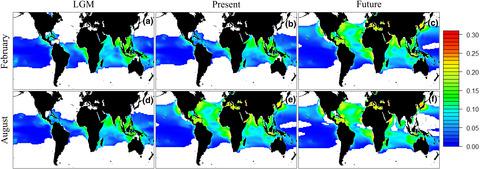当前位置:
X-MOL 学术
›
Glob. Change Biol.
›
论文详情
Our official English website, www.x-mol.net, welcomes your
feedback! (Note: you will need to create a separate account there.)
Projected expansion of Trichodesmium's geographical distribution and increase in growth potential in response to climate change.
Global Change Biology ( IF 10.8 ) Pub Date : 2020-09-01 , DOI: 10.1111/gcb.15324 Tobias G Boatman 1 , Graham J G Upton 2 , Tracy Lawson 1 , Richard J Geider 1
Global Change Biology ( IF 10.8 ) Pub Date : 2020-09-01 , DOI: 10.1111/gcb.15324 Tobias G Boatman 1 , Graham J G Upton 2 , Tracy Lawson 1 , Richard J Geider 1
Affiliation

|
Estimates of marine N2 fixation range from 52 to 73 Tg N/year, of which we calculate up to 84% is from Trichodesmium based on previous measurements of nifH gene abundance and our new model of Trichodesmium growth. Here, we assess the likely effects of four major climate change‐related abiotic factors on the spatiotemporal distribution and growth potential of Trichodesmium for the last glacial maximum (LGM), the present (2006–2015) and the end of this century (2100) by mapping our model of Trichodesmium growth onto inferred global surface ocean fields of pCO2, temperature, light and Fe. We conclude that growth rate was severely limited by low pCO2 at the LGM, that current pCO2 levels do not significantly limit Trichodesmium growth and thus, the potential for enhanced growth from future increases in CO2 is small. We also found that the area of the ocean where sea surface temperatures (SST) are within Trichodesmium's thermal niche increased by 32% from the LGM to present, but further increases in SST due to continued global warming will reduce this area by 9%. However, the range reduction at the equator is likely to be offset by enhanced growth associated with expansion of regions with optimal or near optimal Fe and light availability. Between now and 2100, the ocean area of optimal SST and irradiance is projected to increase by 7%, and the ocean area of optimal SST, irradiance and iron is projected to increase by 173%. Given the major contribution of this keystone species to annual N2 fixation and thus pelagic ecology, biogeochemistry and CO2 sequestration, the projected increase in the geographical range for optimal growth could provide a negative feedback to increasing atmospheric CO2 concentrations.
中文翻译:

应对气候变化,预计毛线虫的地理分布将扩大,增长潜力将增加。
海洋N 2固定的估计范围为52至73 Tg N /年,其中,根据以前对nif H基因丰度的测量和我们新的Trichodesmium生长模型,我们估计高达84%来自Trichodesmium。在这里,我们评估了与气候变化有关的四种主要非生物因素对上次冰期最大值(LGM),当前(2006-2015)和本世纪末(2100)的毛线虫的时空分布和生长潜力的可能影响。通过将我们的Trichodesmium生长模型映射到p CO 2的推断全球地表海洋领域,温度,光和铁。我们得出的结论是,LGM处的低p CO 2严重限制了生长速率,当前的p CO 2水平不会显着限制毛线虫的生长,因此,未来CO 2的增加可促进生长。我们还发现海洋表面温度(SST)处于Trichodesmium之内从LGM到现在,其热能利基增加了32%,但是由于持续的全球变暖导致SST的进一步增加将使该面积减少9%。但是,与最佳或接近最佳铁和光利用率的区域扩展相关的增长增强可能会抵消赤道范围的缩小。从现在到2100年,最佳SST和辐照度的海洋面积预计将增加7%,而最佳SST,辐照度和铁含量的海洋面积预计将增加173%。考虑到该关键物种对每年的N 2固定以及上层生态学,生物地球化学和CO 2固存的主要贡献,为最佳生长而预计的地理范围增加可能为大气中CO的增加提供负面反馈2浓度。
更新日期:2020-10-19
中文翻译:

应对气候变化,预计毛线虫的地理分布将扩大,增长潜力将增加。
海洋N 2固定的估计范围为52至73 Tg N /年,其中,根据以前对nif H基因丰度的测量和我们新的Trichodesmium生长模型,我们估计高达84%来自Trichodesmium。在这里,我们评估了与气候变化有关的四种主要非生物因素对上次冰期最大值(LGM),当前(2006-2015)和本世纪末(2100)的毛线虫的时空分布和生长潜力的可能影响。通过将我们的Trichodesmium生长模型映射到p CO 2的推断全球地表海洋领域,温度,光和铁。我们得出的结论是,LGM处的低p CO 2严重限制了生长速率,当前的p CO 2水平不会显着限制毛线虫的生长,因此,未来CO 2的增加可促进生长。我们还发现海洋表面温度(SST)处于Trichodesmium之内从LGM到现在,其热能利基增加了32%,但是由于持续的全球变暖导致SST的进一步增加将使该面积减少9%。但是,与最佳或接近最佳铁和光利用率的区域扩展相关的增长增强可能会抵消赤道范围的缩小。从现在到2100年,最佳SST和辐照度的海洋面积预计将增加7%,而最佳SST,辐照度和铁含量的海洋面积预计将增加173%。考虑到该关键物种对每年的N 2固定以及上层生态学,生物地球化学和CO 2固存的主要贡献,为最佳生长而预计的地理范围增加可能为大气中CO的增加提供负面反馈2浓度。











































 京公网安备 11010802027423号
京公网安备 11010802027423号